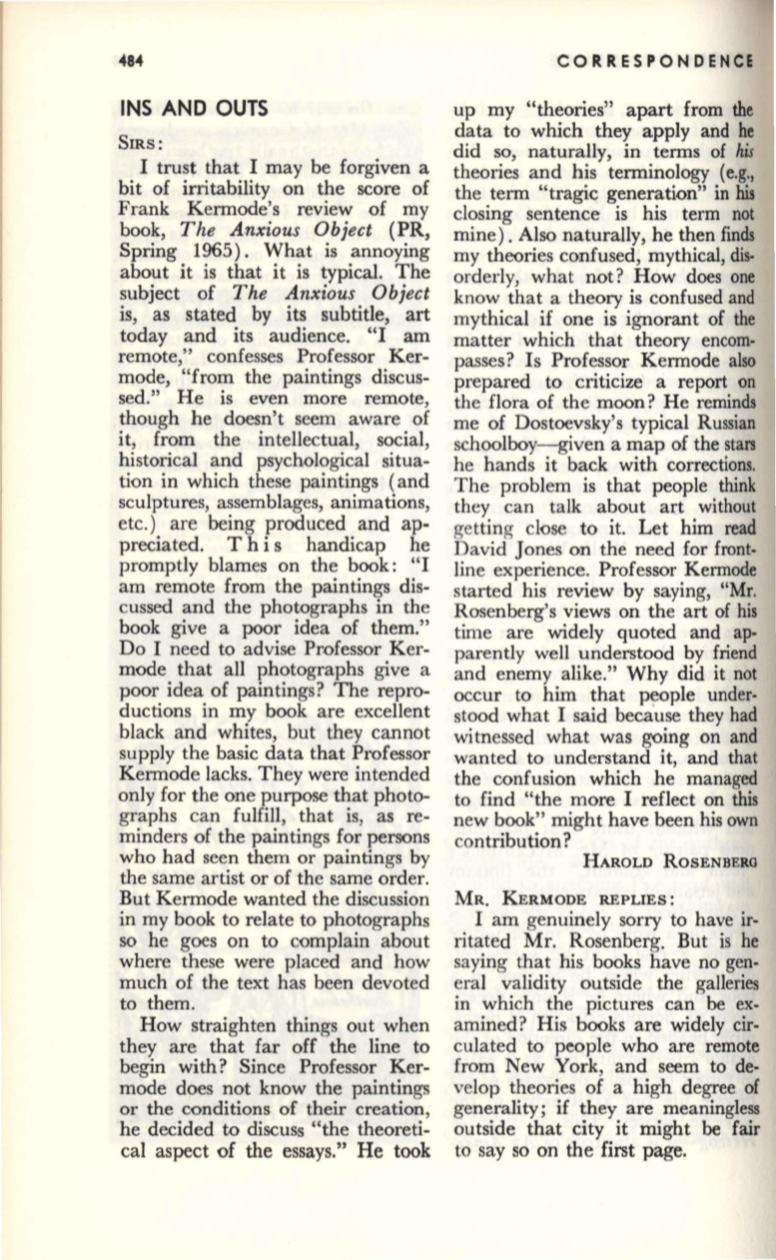
INS AND OUTS
SIRS:
I trust that I may be forgiven a
bit of irritability on the score of
Frank Kermode's review of my
book,
The Anxious Object
(PR,
Spring 1965). What is annoying
about it is that it is typical. The
subject of
The Anxious Object
is, as stated by its subtitle, art
today and its audience. "I am
remote," confesses Professor Ker–
mode, "from the paintings discus–
sed." He is even more remote,
though he doesn't seem aware of
it, from the intellectual, social,
historical and psychological situa–
tion in which these paintings (and
sculptures, assemblages, animations,
etc.) are being produced and ap–
preciated. T his handicap he
promptly blames on the book: "I
am remote from the paintings dis–
cussed and the photographs in the
book give a poor idea of them."
Do I need to advise Professor Ker–
mode that all photographs give a
poor idea of paintings? The repro–
ductions in my book are excellent
black and whites, but they cannot
supply the basic data that Professor
Kermode lacks. They were intended
only for the one purpose that photo–
graphs can fulfill, that is, as re–
minders of the paintings for persons
who had seen them or paintings by
the same artist or of the same order.
But Kermode wanted the discussion
in my book to relate to photographs
so he goes on to complain about
where these were placed and how
much of the text has been devoted
to them.
How straighten things out when
they are that far off the line to
begin with? Since Professor Ker–
mode does not know the paintings
or the conditions of their creation,
he decided
to
discuss "the theoreti–
cal aspect of the essays." He took
CORRESPONDENCE
up my "theories" apart from the
data to which they apply and
he
did so, naturally, in terms of
his
theories and his terminology (e.g.,
the term "tragic generation" in
his
closing sentence is his term not
mine). Also naturally, he then fmds
my theories confused, mythical, dis–
orderly, what not? How does one
know that a theory is confused and
mythical if one is ignorant of the
matter which that theory encom–
passes? Is Professor Kermode also
prepared to criticize a report on
the flora of the moon? He reminds
me of Dostoevsky's typical Russian
schoolboy-given a map of the stan
he hands it back with corrections.
The problem is that people think
they can talk about art without
getting close to it. Let
him
read
David Jones on the need for front–
line experience. Professor Kermode
started his review by saying, "Mr.
Rosenberg's views on the art of
his
time are widely quoted and ap–
parently well understood by friend
and enemy alike." Why did it not
occur to him that
~ple
under–
stood what I said because they had
witnessed what was going on and
wanted to understand it, and that
the confusion which he managed
to find "the more I reflect on
this
new book" might have been his own
contribution?
HAROLD ROSENBERG
MR. KERMODE REPLIES:
I am genuinely sorry to have ir–
ritated Mr. Rosenberg. But is he
saying that his books have no gen–
eral validity outside the galleries
in which the pictures can
be
ex–
amined? His books are widely cir–
culated to people who are remote
from New York, and seem
to
de–
velop theories of a high degree
of
generality; if they are meaningless
outside that city it might
be fair
to say so on the first page.


